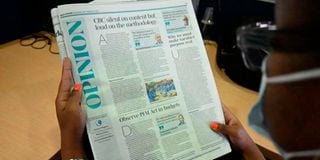Reader’s guide on leading articles and other things that are editorial

A newspaper fan reads articles in the Opinion section of the ‘Daily Nation’.
A Column, Editorial and News Story walk into a bar. “Hey,” News Story says. “Why does everybody think I’m you guys?” “Beats me,” Column replies. “Y’all don’t even live on the same page as us.”
I read this made-up story in an article, “What’s the difference between a column, editorial and news story?”, in the online version of a Texas newspaper, Jacksonville Progress. The imaginary story illustrates that while newspaper editorials and columns are very different from news stories, the differences aren’t always well understood by readers.
Research by the American Press Institute shows that 32 per cent of Americans find it difficult to distinguish news from opinion in the media. There is no comparable research in Kenya but anecdotal evidence shows many local readers can’t tell the difference between an editorial, column and news story.
I’ve had readers complain, because they disagreed with them, that certain editorials or columns are biased. Editorials and columns are meant to be, if you like, biased; they offer opinions the reader may, or may not, agree with. They’re meant to explain, analyse, criticise or praise, and influence public opinion.
At the very least, editorials and columns provoke debate on important issues of the day. News stories, on the other hand, inform the reader; they provide facts upon which an editorial or column might be based.
For example, in yesterday’s Nation, there are two editorials, as usual. The first, “Political will, not laws, can end corruption”, argues that ending graft requires strong political will and legal resolve, not just new laws. It is based on news stories on corruption.
The second, “Give public jobs on merit”, argues that holders of public office must be beyond reproach. It is reacting to the appointment of the former IEBC chief executive, Mr Ezra Chiloba, as director-general of the Communications Authority of Kenya. It’s based on a news story reported on Wednesday.
The imaginary bar story is concerned with the difference between editorials and columns on the one hand and news stories on the other. A second concern that is not addressed in that story is that many readers in Kenya don’t know the difference between editorials and columns. An editorial is the opinion of the news organisation. A column is the opinion of the writer. Columnists can use the first pronoun “I”. Editorial writers can only use “we”. Nation editorials are the voice of the NMG. Columns are personal views.
There should be no doubt Nation editorials and columns are separate from news stories, and editorial are different from columns. Nation editorials and columns are published in pages clearly labelled “Opinion”. On Sunday, the Nation has additional “Sunday Review” section, in which more opinion columns and analyses are published.
However, readers may still not always know the difference between editorials, columns and news stories because of terminology, especially the use of the word “editorial” to cover everything in the newspaper except advertising. “Editorial” has several other meanings.
One is “relating to the part of a newspaper that contains news, information or comment as opposed to advertising”. Yesterday’s Nation is 30 per cent editorial, 70 per cent advertising. Policy guidelines guide our editorial standards. We are committed to promoting media freedom and editorial independence.
In British journalism, an editorial is also called the leading article, the lead or leader. In American journalism, it is just called editorial, no more. In Kenya, we use all those terms.
In British journalism, the most important story in a newspaper published on the front page is called the lead, lead story or splash. In yesterday’s Nation the splash is “Uhuru cuts Ruto power in reshuffle”, which is continued on page 4. In US journalism, such a story is just called the leading article.
The different meanings of “editorial” and the interchangeability and confusion of other terms used to describe editorial content compound the problem for readers who find it difficult to understand the difference between a column, editorial and news story.
The Public Editor is an independent news ombudsman who handles readers’ complaints on editorial matters including accuracy and journalistic standards. Email: [email protected]. Call or text 0721989264.




